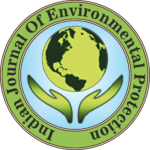IJEP 42(13): 1572-1577 : Vol. 42 Issue. 13 (Conference 2022)
A. Kumar and D. Basu*
Motilal Nehru National Institute of Technology Allahabad, Prayagraj – 211 004, Uttar Pradesh, India
Abstract
The focus of the current study is on phenolic syntan removal from synthetic industrial effluent utilising a batch mode electrochemical (EC) technique with vertical rotating cylindrical aluminium electrodes. The impact of operating parameters, that is rotational speed of electrode (RSE), current intensity, electrolysis time and initial pH on the removal of phenolic syntan was investigated to compare the specific energy consumption (SEC) in each operating condition. It was found that when electrolysis time and current intensity increased, the COD, syntan removal and SEC value also increased. In contrast, COD and syntan removal decreased beyond the optimum pH value. In the case of RSE, it was noted that an increase in RSE resulted in increased COD and syntan removal. However, a rise in RSE above the optimal level revealed a fall in the elimination of COD and syntan. The optimum operating condition was obtained for the case of maximum COD removal efficiency (75%), corresponding to current: 4A, initial pH: 4, electrolysis time: 60 min and RSE: 70 rpm. In comparison to the absorbance value in the influent, the effluent absorbance at optimum conditions was found to decrease (-3.975), indicating syntan removal. The peak identified through the FTIR analysis of the influent sample was in the region between 1443 -1572 C/m and 1173 C/m, corresponding to the C=C stretching and C-H bending. This indicated presence of aromatic ring in syntan. Above mentioned peak was not identifiable in the treated sample showing the removal of syntan from synthetic wastewater. The FTIR analysis also indicated the conversion of syntan into the lower molecular weight by-product, that is quinone. The SEC calculated at the optimum working condition was found to be 24 KWh/m3.
Keywords
Removal, Syntan, Electrochemical, Rotating aluminium electrode
References
- Ganesh, R. and R.A. Ramanujam. 2009. Biological waste management of leather tannery effluents in India: Current options and future research needs. Int. J. Env. Eng., 1: 165-186.
- Danhong, S., et al. 2008. Evaluation of environmental impact of typical leather chemicals. Part II: Biodegradability of organic tanning agents by activated sludge. J. Soc. Leather Tech. Chemists. 92: 59-64.
- Senthilvelan, T., J. Kanagaraj and R.C. Panda. 2017. Effective bioremoval of syntan using fungal laccase to reduce pollution from effluent. Int. J. Env. Sci. Tech., 15: 1429-1440.
- Thankappan, R., et al. 2015. Removal of leather tanning agent syntan from aqueous solution using Fenton oxidation followed by GAC adsorption. J. Ind. Eng. Chem., 21: 483-488.
- Aruldoss, U., et al. 2011. Photocatalytic degradation of phenolic syntan using TiO2 impregnated activated carbon. J. Colloid Interface Sci., 355: 204-209.
- Thankappan, R., et al. 2017. Studies on removal of phenol sulfonic acid-syntan in aqueous medium using ozonation. Env. Tech., 39: 1-13.
- Ferella, F., et al. 2013. Advanced treatment of industrial wastewater by membrane filtration and ozonisation. Desalination. 313: 1-11.
- Sinha, R. and S. Mathur. 2015. Use of activated silica sol as a coagulant aid to remove aluminium from water defluoridated by electrocoagulation. Desalination Water Treatment. 57: 16790-16799.
- Kumar, A. and D. Basu. 2018. Treatment of dairy wastewater by electrocoagulation using vertically held rotating cylindrical aluminium electrodes. Proceedings of International Conference on Sustainable solutions in industrial pollution water and wastewater treatment, Aligarh Muslim University, Uttar Pradesh. pp 33-35.
- Zodi, S., et al. 2010 Treatment of the industrial wastewaters by electrocoagulation: Optimization of coupled electrochemical and sedimentation processes. Desalination. 261(1-2): 186-190.
- Katal, R. and H. Pahlavanzadeh. 2011. Influence of different combinations of aluminium and iron electrode on electrocoagulation efficiency: Application to the treatment of paper mill wastewater. Desalination. 265(1-3): 199-205.
- Tezcan, U.U., A.S. Koparal and U.B. Ogutveren. 2009. Electrocoagulation of vegetable oil refinery wastewater using aluminium electrodes. J. Env. Manage., 90(1): 428-433.
- Kobya, M., et al. 2010. Treatment of cadmium and nickel electroplating rinse water by electrocoagulation. Env. Tech., 31(13): 1471-1481.
- Hassoune, J., et al. 2017. Removal of hydrolyzable and condensed tannins from aqueous solutions by electrocoagulation process. J. Env. Eng., 143(6): 04017010.
- Buso, A., et al. 2000. Electrochemical removal of tannins from aqueous solutions. Ind. Eng. Chem. Res., 39: 494-499.
- Murugananthan, M., G.B. Raju and S. Prabhakar. 2005. Removal of tannins and polyhydroxy phenols by electrochemical techniques. J. Chem. Tech. Biotech., 80: 1188-1197.
- Lu, J., et al. 2015. Removing heavy metal ions with continuous aluminium electrocoagulation: A study on back mixing and utilization rate of electro-generated Al ions. Chem. Eng. J., 267: 86-92.
- APHA. 1995. Standard methods for the examination of water and wastewater (19th edn). American Public Health Association, Washington DC.
- Gebologlu, U. 2010. Removal of arsenic by electrochemical wastewater treatment process. MSc. Thesis. Gebze Institute of Turkey.
- Lekhlif, B., et al. 2014. Study of the electrocoagulation of electroplating industry wastewaters charged by nickel (II) and chromium (VI). J. Mater. Env. Sci., 5: 111-120.
- Chen, G., X. Chen and P.L. Yue. 2000. Electrocoagulation and electroflotation of restaurant wastewater. J. Env. Eng., 126: 858-863.
- Khandekar, V. and A.K. Saroha. 2013. Electrocoagulation for the treatment of textile industry effluent-A review. J. Env. Manage., 128: 949-963.
- Bensadok, K., N.E. Hanafi and F. Lapicque. 2011. Electrochemical treatment of dairy effluent using combined Al and Ti/Pt electrodes system. Desalination. 280: 244-251.
- Kobya, M., et al. 2006. Treatment of potato chips manufacturing wastewater by electrocoagulation. Desalination. 190(1-3): 201-211.
